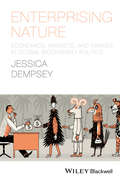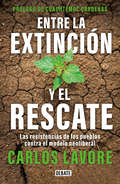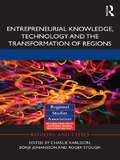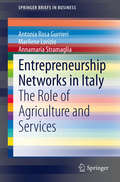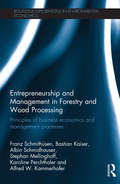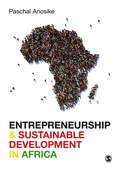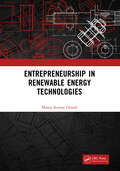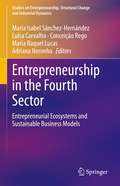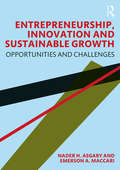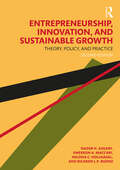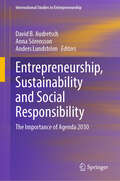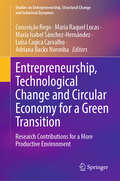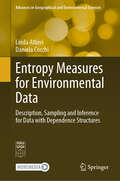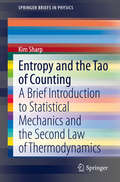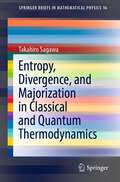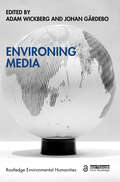- Table View
- List View
Enterprising Nature: Economics, Markets, and Finance in Global Biodiversity Politics (Antipode Book Series)
by Jessica DempseyWinner of the 2018 James M. Blaut Award in recognition of innovative scholarship in cultural and political ecology!Enterprising Nature explores the rise of economic rationality in global biodiversity law, policy and science. To view Jessica's animation based on the book's themes please visit http://www.bioeconomies.org/enterprising-nature/ Examines disciplinary apparatuses, ecological-economic methodologies, computer models, business alliances, and regulatory conditions creating the conditions in which nature can be produced as enterprising Relates lively, firsthand accounts of global processes at work drawn from multi-site research in Nairobi, Kenya; London, England; and Nagoya, Japan Assesses the scientific, technical, geopolitical, economic, and ethical challenges found in attempts to ‘enterprise nature’ Investigates the implications of this ‘will to enterprise’ for environmental politics and policy
Entre la extinción y el rescate: Las resistencias de los pueblos contra el modelo neoliberal
by Carlos LavorePrólogo de Cuauhtémoc Cárdenas «Es crucial para nuestros países recuperar el control de los bienes y recursos naturales para su aprovechamiento, no explotación, en beneficio de las regiones y su población.» Cuauhtémoc Cárdenas El planeta atraviesa un estado de emergencia climática. La región latinoamericana padece los efectos del despojo. Pueblos, comunidades y sociedad organizada ofrecen una terca resistencia. Carlos Lavore, autor de diversos trabajos sobre participación, planeación y comunicación, da cuenta en este libro de lo que está ocurriendo a escala global con los bosques, hielos, suelos y agua, cuya brutal explotación se traduce en desastres “naturales” y colapsos parciales con severas afectaciones a la vida. A partir del recuento de los saqueos de bienes y recursos naturales en los últimos 40 años en América Latina, Lavore explica el proceso de extinción de la vida planetaria, o de buena parte de ella; reflexiona sobre los efectos negativos que ha producido la concentración del poder financiero, político y mediático; y pone el acento en las posibilidades de rescate. Si bien no existe un proyecto de liberación asumido colectivamente, este libro visibiliza las múltiples resistencias y consigna la potencialidad transformadora de distintas alternativas políticas y sociales a lo largo de América Latina, con un énfasis particular en México; como la experiencia del pueblo boliviano, el movimiento de los sin tierra, los zapatistas en el sureste mexicano, las fogatas populares en Cherán, el pueblo yaqui en Sonora, los movimientos de mujeres en las grandes ciudades y una notable cantidad de resistencias locales. Entre la extinción y el rescate ofrece una interpretación que resultará útil para la articulación política de quienes sueñan con reinventar el mundo, reinventar América Latina,reinventarnos.
Entrepreneurial Knowledge, Technology and the Transformation of Regions: Entrepreneurial Knowledge, Technology And The Transformation Of Regions (Regions and Cities #68)
by Charlie Karlsson Börje Johansson Roger StoughIn recent years, policy makers have given much credence to the role of entrepreneurship in the transformation of regions. As a result, a new set of policy responses have emerged that focus on the support of new venture creation, small business growth and idea generation and commercialization. While there is a wealth of research about entrepreneurship in general, less attention has been given to the development of new tools and programs in support of entrepreneurial activities, and to the ways in which the emergence, the character and the types of entrepreneurship policies might differ between countries. In particular, the transatlantic perspective is of special interest because of the pioneering role of the United States in this area, and also due to the European Union's focus on economic competitiveness. The contributions included in this book explore the emergence of entrepreneurship policies from a transatlantic comparative perspective and address different aspects of entrepreneurship policies including local entrepreneurship policies and the relationship between knowledge-based industries and entrepreneurship policies.
Entrepreneurial Learning City Regions: Delivering on the UNESCO 2013, Beijing Declaration on Building Learning Cities
by Judith James, Jean Preece and Raúl Valdés-CoteraThis book proposes an alternative strategy to improve and sustain prosperity, through the creation of an entrepreneurial culture in learning cities or city regions. The edited collection provides insights into how entrepreneurship, education, job creation and social inclusion can be aligned through entrepreneurial learning, in the context of territorial development. With rich and varied contributions from a wide field, including policy makers, entrepreneurs, an investment banker, leaders of universities and councils, the voluntary sector, scientists, educators and students, it reviews and assesses how learning cities and regions may become more prosperous by investing in the development of entrepreneurial skills throughout lifelong learning. Reinforced by examples on developing and retaining entrepreneurial people, this book contributes to our understanding of how entrepreneurial learning can be fostered in different city and city-region contexts. It makes an interesting contribution to the field in terms of mapping out complex issues and testing the practical validity of the concept, while also providing rich and insightful case studies centred on the Welsh experience with entrepreneurial learning city regions. The high quality international contributions demonstrate the new worldwide interest in developing an entrepreneurial culture for the benefit of a city or region, rather than an entrepreneurial mind-set for individual benefit. This fascinating subject will be of interest to many social scientists, policymakers, and practitioners. It will be found especially valuable for professionals involved in economic, inclusive and sustainable city or regional development.
Entrepreneurship Networks in Italy
by Antonia Rosa Gurrieri Marilene Lorizio Annamaria StramagliaIn light of the recent dynamics of the recession sparked by the global economic crisis, a roadmap for the growth and recovery of national economies is urgently needed. As such, this book focuses on the potential offered not only by the manufacturing sector but also by the agricultural and tertiary sectors. In fact, during the crisis these sectors demonstrated remarkable resilience in the Italian economy and there have even been positive trends in specific segments. This book points out how an exit strategy could be applied that involves all economic sectors and which can be replicated in various national economies.
Entrepreneurship and Management in Forestry and Wood Processing: Principles of Business Economics and Management Processes (Routledge Explorations in Environmental Economics)
by Franz Schmithüsen Bastian Kaiser Albin Schmidhauser Stephan Mellinghoff Karoline Perchthaler Alfred W. KammerhoferForestry has long been in a rather favourable position in offering a valuable raw material source in high demand. However, with rapidly changing end-user demands and cost competitiveness within the forest and wood chain as a whole, the industry is needing to adapt. Explaining entrepreneurial action as part of a chain of comprehensive value-added processes leads to a new perception of forest production and wood processing. This book applies the main concepts of modern managerial science to the world of forestry and is the perfect book for students studying forestry and wood processing, as well as entrepreneurs and managers within the sector. Topics are covered from an entrepreneurial perspective and include perspectives from accounting, finance, economics, supply chain management, marketing and strategy.
Entrepreneurship and Organizational Change: Managing Innovation and Creative Capabilities (Contributions to Management Science)
by Vanessa RattenChange is a part of any organization, but in order to compete in the globally connected business environment, organizations also need to incorporate an entrepreneurial focus. This book investigates how successful organizations have intelligently responded to change by utilizing creative, innovative and dynamic solutions. Pursuing a complexity theory approach, it analyzes the changes currently taking place, and discusses the optimal use of organizational resources. This provides the reader with a more cohesive way to assess the current and potential future challenges faced by organizations as they respond to environmental, social and economic changes.
Entrepreneurship and Sustainable Development in Africa
by Paschal AnosikeHigh foreign aid dependence, poor human capital, rising high youth unemployment and poverty are just some of the reasons that Africa represents such a striking symbol of global inequality today. In this book, the author draws on his research and experience of working with key stakeholders to explore how Africa can take advantage of the knowledge economy and 4th Industrial Revolution opportunities to rebuild from the Covid-19 pandemic and empower its people and encourage entrepreneurship. Entrepreneurship and Sustainable Development in Africa is a book the African political class, economic policy and development experts, the donor community, academic researchers and students of business and international development can rely on for a better understanding and solutions to Africa’s historical and contemporary socio-economic problems. Paschal Anosike is Associate Professor of Entrepreneurship and Innovation and the founding Director of Centre for African Entrepreneurship and Leadership (CAEL) at the University of Wolverhampton.
Entrepreneurship and Sustainable Development in Africa
by Paschal AnosikeHigh foreign aid dependence, poor human capital, rising high youth unemployment and poverty are just some of the reasons that Africa represents such a striking symbol of global inequality today. In this book, the author draws on his research and experience of working with key stakeholders to explore how Africa can take advantage of the knowledge economy and 4th Industrial Revolution opportunities to rebuild from the Covid-19 pandemic and empower its people and encourage entrepreneurship. Entrepreneurship and Sustainable Development in Africa is a book the African political class, economic policy and development experts, the donor community, academic researchers and students of business and international development can rely on for a better understanding and solutions to Africa’s historical and contemporary socio-economic problems. Paschal Anosike is Associate Professor of Entrepreneurship and Innovation and the founding Director of Centre for African Entrepreneurship and Leadership (CAEL) at the University of Wolverhampton.
Entrepreneurship in Context (Routledge Studies in Entrepreneurship)
by Marco Van Gelderen Enno MasurelMuch research in entrepreneurship presents results as if they are universally and timelessly valid. Entrepreneurship in Context takes the opposite tack – it studies entrepreneurship as a context bound phenomenon. For entrepreneurship, the importance of context goes beyond gaining understanding and avoiding mistakes. The reciprocal influence exercised by the entrepreneurial venture and its corresponding context is at the very heart of the entrepreneur as an agent of change. The book addresses context in a narrow sense, i.e. a person’s life situation and local, situational characteristics. It also deals with wider contexts such as social, industry, cultural, ethnic, sustainability-related, institutional, and historical contexts. The book studies the interconnectedness of all these various sub-contexts. It zooms in on the actions that entrepreneurs take to involve, engage, and influence their context and shows the changing and dynamic nature of context. It provides lessons for entrepreneurs about which contextual elements should be prioritized, engaged and sought out.
Entrepreneurship in Renewable Energy Technologies
by Manoj Kumar GhosalThis book focusses on various options of taking up ventures for starting entrepreneurship in small/large scale in the field of renewable energy technologies. The book covers the fundamentals of entrepreneurship, renewable energy resources, their technologies involved and applications along with financial evaluations. The book will cater to the needs of students, researchers, various stakeholders, entrepreneurs etc. by providing valuable information on renewable energy technologies and their applications in developing entrepreneurship and establishing enterprise at individual level, specifically focusing on low carbon technology for sustenance of environment which is becoming increasingly important.
Entrepreneurship in the Fourth Sector: Entrepreneurial Ecosystems and Sustainable Business Models (Studies on Entrepreneurship, Structural Change and Industrial Dynamics)
by Conceição Rego Maria Raquel Lucas María Isabel Sánchez-Hernández Luísa Carvalho Adriana Noronha“The fourth sector” is a relatively new sector that consists of for-benefit organizations that combine market-based approaches of the private sector with the social and environmental aims of the public and non-profit sectors. This book examines trends of entrepreneurship in the fourth sector, describes specific ecosystems fostering new ventures around the world, and characterizes the most common and innovative business models. It covers as well the main effects, among others, of technological change, innovation, and institutional behavior on the sector in the last years.
Entrepreneurship, Innovation and Sustainable Growth: Opportunities and Challenges
by Nader H. Asgary Emerson A. MaccariEntrepreneurship and innovation play a vital role in fostering sustainable development. Advances in technology and communications have both transformed the process of business as well as strengthened the role of entrepreneurship in developed and developing countries. This important book is the first to provide the fundamental concepts and applications for faculty and students in this field, and also serves as a professional reference for practicing entrepreneurs and policymakers. Each chapter provides a clear guide to the conceptual and practical elements that characterize entrepreneurship and the process of new venture formation, including functional strategies in key areas such as marketing, information technology, human resources management, and accounting and finance. Questions and exercises are presented throughout in order to encourage discussion and problem-solving. A quick summary of the important concepts and definitions are also provided. Keeping practicality as the book’s core aim, all chapters include a long case study to set the scene and then draw upon shorter cases from both developing and developed countries to reinforce key learning objectives and the real-world application of the book’s core concepts.
Entrepreneurship, Innovation, and Sustainable Growth: Theory, Policy, and Practice
by Nader H. Asgary Emerson A. Maccari Heloisa C. Hollnagel Ricardo L.P. BuenoEntrepreneurship and innovation play a vital role in fostering sustainable development. Advances in technology and communications have both transformed the process of business and strengthened the role of entrepreneurship in developed and developing countries. This new edition of Entrepreneurship, Innovation, and Sustainable Growth provides the fundamental concepts and applications for faculty and students in this field, and also serves as a professional reference for practicing entrepreneurs and policymakers. Each chapter provides a clear guide to the conceptual and practical elements that characterize entrepreneurship and the process of new venture formation, including functional strategies in key areas such as marketing, information technology, human resources management, and accounting and finance. Updated throughout to take account of recent developments in topics such as environmental impacts, diversity and inclusion, and COVID-19, the book is a comprehensive and holistic approach to the theory, policy, and practice of entrepreneurship and innovation. Keeping practicality as the book’s core aim, all chapters include a long case study to set the scene and then draw upon shorter cases from both developing and developed countries to reinforce key learning objectives and the real-world application of the book’s core concepts. With new questions and exercises presented throughout in order to encourage discussion and problem-solving, quick summaries of the important concepts and definitions, and extensive support for lecturers and students, Entrepreneurship, Innovation, and Sustainable Growth, Second Edition, is ideal for students at undergraduate and postgraduate level.
Entrepreneurship, Sustainability and Social Responsibility: The Importance of Agenda 2030 (International Studies in Entrepreneurship #48)
by David B. Audretsch Anders Lundström Anna SörenssonThis edited collection unveils the pivotal role of entrepreneurship in realizing the 2030 Agenda for Sustainable Development. Global scholars converge to scrutinize entrepreneurship's centrality in the transformative framework endorsed by the United Nations. Encompassing nuanced examinations, the volume surveys evolving perspectives on Agenda 2030, appraises policy implications and scrutinizes entrepreneurship's potency as a change catalyst. Chapters deal with practical applications, assessing the Agenda's efficacy in nurturing local enterprises. Exploring the interplay between corporate social responsibility and entrepreneurship, the book analyzes the potential of tailoring Sustainable Development Goals to diverse contexts. Furthermore, the book critically analyzes implementation factors and prevailing research gaps in public sector integration. In sum, this compendium exemplifies Agenda 2030's role in driving multifaceted political and local metamorphoses across sectors and is useful for researchers and policymakers alike.
Entrepreneurship, Technological Change and Circular Economy for a Green Transition: Research Contributions for a More Productive Environment (Studies on Entrepreneurship, Structural Change and Industrial Dynamics)
by Luísa Cagica Carvalho Conceição Rego Adriana Backx Noronha Maria Raquel Lucas María Isabel Sánchez-HernándezThis book is a comprehensive and timely publication that aims to be an essential reference source, building on contemporary research in the fields of circular economy and green transition in relation to entrepreneurship and technological change. This book aims to address a range of approaches including, but not limited to, the conceptual, theoretical, and case studies related to the topics of the book. The topical focus is on how circular economy contributions, energy infrastructure, green transition, and digital transformation are contributing to attaining the Sustainable Development Goals (SDGs). The expert contributions in the book particularly help us learn more about the answers to the current challenges of the green transition as well as how the necessary technological change will impact, mainly, the enterprises and the field of agriculture production and agribusiness. The book is mainly intended to support an academic audience (academics, university teachers, researchers, and post-graduate students – both Master's and Doctorate levels). In addition, this book will be of benefit to institutional experts, developers, and researchers in the fields of Entrepreneurship and technological change in circular economy and green transition.
Entropy Measures for Environmental Data: Description, Sampling and Inference for Data with Dependence Structures (Advances in Geographical and Environmental Sciences)
by Daniela Cocchi Linda AltieriThis book shows how to successfully adapt entropy measures to the complexity of environmental data. It also provides a unified framework that covers all main entropy and spatial entropy measures in the literature, with suggestions for their potential use in the analysis of environmental data such as biodiversity, land use and other phenomena occurring over space or time, or both. First, recent literature reviews about including spatial information in traditional entropy measures are presented, highlighting the advantages and disadvantages of past approaches and the difference in interpretation of their proposals. A consistent notation applicable to all approaches is introduced, and the authors’ own proposal is presented. Second, the use of entropy in spatial sampling is focused on, and a method with an outstanding performance when data show a negative or complex spatial correlation is proposed. The last part of the book covers estimating entropy and proposes a model-based approach that differs from all existing estimators, working with data presenting any departure from independence: presence of covariates, temporal or spatial correlation, or both. The theoretical parts are supported by environmental examples covering point data about biodiversity and lattice data about land use. Moreover, a practical section is provided for all parts of the book; in particular, the R package SpatEntropy covers not only the authors’ novel proposals, but also all the main entropy and spatial entropy indices available in the literature. R codes are supplemented to reproduce all the examples. This book is a valuable resource for students and researchers in applied sciences where the use of entropy measures is of interest and where data present dependence on space, time or covariates, such as geography, ecology, biology and landscape analysis.
Entropy Theory and its Application in Environmental and Water Engineering
by Vijay P. SinghEntropy Theory and its Application in Environmental and Water Engineering responds to the need for a book that deals with basic concepts of entropy theory from a hydrologic and water engineering perspective and then for a book that deals with applications of these concepts to a range of water engineering problems. The range of applications of entropy is constantly expanding and new areas finding a use for the theory are continually emerging. The applications of concepts and techniques vary across different subject areas and this book aims to relate them directly to practical problems of environmental and water engineering.The book presents and explains the Principle of Maximum Entropy (POME) and the Principle of Minimum Cross Entropy (POMCE) and their applications to different types of probability distributions. Spatial and inverse spatial entropy are important for urban planning and are presented with clarity. Maximum entropy spectral analysis and minimum cross entropy spectral analysis are powerful techniques for addressing a variety of problems faced by environmental and water scientists and engineers and are described here with illustrative examples.Giving a thorough introduction to the use of entropy to measure the unpredictability in environmental and water systems this book will add an essential statistical method to the toolkit of postgraduates, researchers and academic hydrologists, water resource managers, environmental scientists and engineers. It will also offer a valuable resource for professionals in the same areas, governmental organizations, private companies as well as students in earth sciences, civil and agricultural engineering, and agricultural and rangeland sciences.This book:Provides a thorough introduction to entropy for beginners and more experienced usersUses numerous examples to illustrate the applications of the theoretical principlesAllows the reader to apply entropy theory to the solution of practical problemsAssumes minimal existing mathematical knowledgeDiscusses the theory and its various aspects in both univariate and bivariate casesCovers newly expanding areas including neural networks from an entropy perspective and future developments.
Entropy and the Second Law of Thermodynamics: ... or Why Things Tend to Go Wrong and Seem to Get Worse
by Robert FleckThis book is a brief and accessible popular science text intended for a broad audience and of particular interest also to science students and specialists. Using a minimum of mathematics, a number of qualitative and quantitative examples, and clear illustrations, the author explains the science of thermodynamics in its full historical context, focusing on the concepts of energy and its availability and transformation in thermodynamic processes. His ultimate aim is to gain a deep understanding of the second law—the increase of entropy—and its rather disheartening message of a universe descending inexorably into chaos and disorder. It also examines the connection between the second law and why things go wrong in our daily lives. Readers will enhance their science literacy and feel more at home on the science side of author C. P. Snow's celebrated two-culture, science-humanities divide, and hopefully will feel more at home in the universe knowing that the disorder we deal with in our daily lives is not anyone's fault but Nature's.
Entropy and the Tao of Counting: A Brief Introduction to Statistical Mechanics and the Second Law of Thermodynamics (SpringerBriefs in Physics)
by Kim SharpThis book provides a complete and accurate atomic level statistical mechanical explanation of entropy and the second law of thermodynamics. It assumes only a basic knowledge of mechanics and requires no knowledge of calculus. The treatment uses primarily geometric arguments and college level algebra. Quantitative examples are given at each stage to buttress physical understanding. This text is of benefit to undergraduate and graduate students, as well as educators and researchers in the physical sciences (whether or not they have taken a thermodynamics course) who want to understand or teach the atomic/molecular origins of entropy and the second law. It is particularly aimed at those who, due to insufficient mathematical background or because of their area of study, are not going to take a traditional statistical mechanics course.
Entropy, Divergence, and Majorization in Classical and Quantum Thermodynamics (SpringerBriefs in Mathematical Physics #16)
by Takahiro SagawaRich information-theoretic structure in out-of-equilibrium thermodynamics exists in both the classical and quantum regimes, leading to the fruitful interplay among statistical physics, quantum information theory, and mathematical theories such as matrix analysis and asymptotic probability theory. The main purpose of this book is to clarify how information theory works behind thermodynamics and to shed modern light on it.The book focuses on both purely information-theoretic concepts and their physical implications. From the mathematical point of view, rigorous proofs of fundamental properties of entropies, divergences, and majorization are presented in a self-contained manner. From the physics perspective, modern formulations of thermodynamics are discussed, with a focus on stochastic thermodynamics and resource theory of thermodynamics. In particular, resource theory is a recently developed field as a branch of quantum information theory to quantify “useful resources” and has an intrinsic connection to various fundamental ideas of mathematics and information theory. This book serves as a concise introduction to important ingredients of the information-theoretic formulation of thermodynamics.
Ents, Elves, and Eriador: The Environmental Vision of J.R.R. Tolkien (Culture of the Land)
by Jonathan Evans Matthew Dickerson&“A fascinating ecocritical evaluation&” of The Hobbit, The Lord of the Rings, The Silmarillion and other works of the master fantasist (Northeastern Naturalist). The Hobbit, The Lord of the Rings, and The Silmarillion are rarely considered to be works of environmental literature or mentioned together with such authors as John Muir, Rachel Carson, or Aldo Leopold. Nonetheless, Tolkien&’s vision of nature is as passionate and has had as profound an influence on his readers as that of many contemporary environmental writers. The burgeoning field of agrarianism provides new insights into Tolkien&’s view of the natural world and environmental responsibility. In Ents, Elves, and Eriador, Matthew Dickerson and Jonathan Evans show how Tolkien anticipated some of the tenets of modern environmentalism in the imagined world of Middle-earth and the races with which it is peopled. Dickerson and Evans examine Tolkien&’s major works as well as his lesser-known stories and essays, comparing his writing to that of the most important naturalists of the past century. A vital contribution to environmental literature and an essential addition to Tolkien scholarship, Ents, Elves, and Eriador offers both Tolkien fans and environmentalists an understanding of Middle-earth that has profound implications for environmental stewardship in the present and the future of our own world. &“This book is for everyone who loves the work of J. R. R. Tolkien, and who loves the world around them.&” —Armchair Interviews &“Anyone who ever thrilled to Tolkien&’s fighting trees, or to the earthy Tom Bombadil, or to the novel charm of the Shire will want to read this important and lovely book.&” —Bill McKibben, Scholar in Residence in Environmental Studies, Middlebury College
Entscheidungen in die weite Zukunft: Ungewissheiten bei der Entsorgung hochradioaktiver Abfälle (Energiepolitik und Klimaschutz. Energy Policy and Climate Protection)
by Dirk Scheer Anne Eckhardt Frank Becker Volker Mintzlaff Roman SeidlIn diesem Open-Access-Buch werden Wege aufgezeigt, mit verschiedenen Formen von Ungewissheiten und der Dynamik von Ungewissheiten bezüglich der Entsorgung radioaktiver Abfälle umzugehen. Die sichere Entsorgung radioaktiver Abfälle erfordert es, über Zeiträume von bis zu einer Million Jahre hinaus zu planen. Ein solches Vorhaben ist von erheblichen Ungewissheiten begleitet, die sich zudem auf dem Entsorgungsweg verändern. Dem Sammelband liegen inter- und transdisziplinäre Forschungsergebnisse zugrunde. Die Autor:innen sprechen in allgemein verständlicher Sprache eine breite Leserschaft an, die sich für die Entsorgung radioaktiver Abfälle oder grundlegender für den Umgang mit Vorhaben, die sehr langfristig angelegt sind, interessiert.
Entwicklung, humanitäre Hilfe und soziale Wohlfahrt: Sozialer Wandel von innen nach außen
by Cornelia C. WaltherIn diesem Buch wird untersucht, wie menschliches Verhalten durch unsere Wünsche, Emotionen, Gedanken und Empfindungen geformt wird und wie sich umgekehrt die Erfahrungen, die sich aus unserem Verhalten ergeben, auf uns selbst, andere und den Planeten auswirken. Auf der Grundlage einer Analyse des ständigen Wechselspiels zwischen diesen vier Ebenen bietet es praktische Lösungen, um systematisch eine nachhaltige gesellschaftliche Veränderungsdynamik in Gang zu setzen. Es wird aufgezeigt, warum der Wandel, zusätzlich zur wirtschaftlichen und politischen Transformation auf der Makroebene, mit einem Bewusstseinswandel auf der Mikroebene beginnt. Dabei stellt er die fehlende Verbindung zwischen Investitionen in die persönliche Befähigung und das kollektive Wohlergehen her. Ein neuartiges theoretisches Paradigma bildet die Grundlage dieses Buches, das in der Perspektive einer kontinuierlichen "Körper-Geist-Herz-Seele-Verbindung" verankert ist. Ausgehend von der Prämisse, dass eine gerechte Gesellschaft allen zugute kommt, wird argumentiert, dass Anstrengungen, die für andere unternommen werden, auf drei Ebenen Vorteile bringen - für den Einzelnen, der handelt, für denjenigen, für den gehandelt wurde, und für die Gesellschaft.
Environing Media (ISSN)
by Adam Wickberg Johan GärdeboThis edited volume interrogates the role of media technologies in the formation of environments, understood both as physical spaces and as epistemological constructs about them. Using the concept of ‘environing media’, the book advances a deeper understanding of how media processes – defined here as the storage, process, and transmission of data – influence human-Earth relations.Virtually all aspects of the interconnected global ecological crisis can be related to the intensification and acceleration of scaling up the human imprint on the planet by technological means. Combining ideas from the humanities, arts, and humanistic social sciences, Environing Media offers a perspective on how we entered the current geological epoch – the Anthropocene. The ten chapters explore colonial, planetary, and elemental environing media, with cases including indigenous history, ocean monitoring, computational history, climate modeling, environmental history, the air as medium, the biosphere, and the Earth system.Drawing upon a breadth of examples and expertise in history, anthropology, geography, cultural history, science and technology studies, and media studies, the book discovers a novel approach to human-Earth histories that demonstrates how technologies have mediated between humans and environments and in the process contributed to a societal feedback loop between knowing and doing environment, each impacting the other. Environing Media is a timely addition for scholars and upper-level students in environmental humanities and media studies.The Open Access version of chapters 1, 2, 3, 4, 5, 7, 8, and 9 are available at http://www.taylorfrancis.com/books/e/9781003282891. Chapters 1, 2, 4, 5, and 7 have been made available under a Creative Commons Attribution-Non Commercial-No Derivatives 4.0 (CC BY-NC-ND 4.0) license. Chapters 3, 8, and 9 have been made available under a Creative Commons Attribution (CC-BY 4.0) license.
